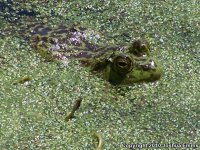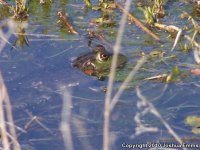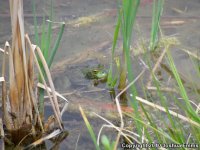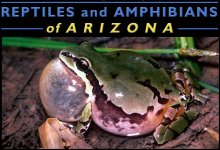| Range: |
 Pretty much any permanent water source in the state. They were introduced as a food source for humans. The eastern populations could be native. No one really knows how far west they were native. We do know they weren't native to the Rio Grande in New Mexico. Pretty much any permanent water source in the state. They were introduced as a food source for humans. The eastern populations could be native. No one really knows how far west they were native. We do know they weren't native to the Rio Grande in New Mexico. |
| Other Names: |
|
| Description: |
At 8 inches or more in length, the American bullfrog is New Mexico's largest frog. It is a green or brownish-green frog with bands or blotches on the legs. Bullfrogs lack the spots and dorsolateral folds characteristic of leopard frogs. Males have tympanums that are as much as twice as large as the eye. Large tadpoles (up to 5.5 inches in length) are larger than the tadpoles of any of our native frogs and toads. Large tadpoles are olive or grayish-olive with diagnostic small, black dots. |
| Similar Species: |
The dorsolateral fold that curves around the tympanum will distinguish this species from all other frogs in New Mexico. Adults may be distinguished by their large size and the lack of large, round dorsal spots as seen in the leopard frogs. |
| Habitat: |
This is a frog of rivers, streams, lakes, cattle tanks, and agricultural ditches and canals; it coexists well with a variety of fishes and crayfish. Bullfrogs prefer deep pools and calm water, and occur from the lowest elevations in the state to montane lakes and ponds at 7,000 feet or more. Tadpoles typically take 1-2 years to metamorphose, so permanent or nearly permanent water is needed for reproduction. |
| Behavior: |
Can be found active day or night. When surprised, juveniles often give a "eep!" or "yip!" alarm call while jumping into water. Bullfrogs are surprisingly mobile. Juveniles, in particular, travel long distances overland among ponds and wetlands |
| Hibernation: |
|
| Reproduction: |
Bullfrogs breed from spring to fall. Egg masses are laid in quiet water and may be attached to or lie within vegetation. Clutches may contain up to 20,000 eggs and cover an area 3 feet in diameter. Adult males make a deep "jug-o-rum" call, which is audible for great distances. |
| Diet: |
Any living thing it can fit into its mouth including snakes, lizards, mice and fish. One was found in a homeowner's pond and was removed because it had eaten over $1000 worth of koi. |
Adapted from account on 














